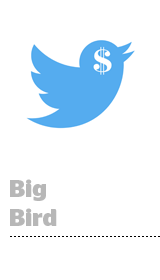 Twitter finally appears to be catching the worm. Or at least its Q2 isn’t a can of worms à la last quarter’s earnings leak.
Twitter finally appears to be catching the worm. Or at least its Q2 isn’t a can of worms à la last quarter’s earnings leak.
The company reported a solid Q2, beating Wall Street’s expectations with a 61% year-over-year increase in revenue to $502 million for the quarter, 25% of which came from direct-response – the “fastest-growing channel we have,” said Twitter CFO Anthony Noto.
Twitter, which also made its results available through a live stream on Periscope, had previously forecasted that its second-quarter revenue would fall between $470 million and $485 million.
Ad revenue overall clocked in at $452 million, up 63% YoY, driven by what Noto referred to as strong demand and growth in Twitter’s advertising base, which hit the 100,000 mark in Q2. Direct-response products such as Promoted Tweets, video cards and mobile app download cards also contributed.
Mobile ad revenue was responsible for 88% of that $452 million.
Although Twitter doesn’t break out revenue for MoPub, its mobile ad exchange business, Noto said it experienced a “similar growth rate” to Twitter’s overall advertising business.
Monthly active users also increased modestly by 15% YoY to 316 million, with mobile representing roughly 80% of total MAUs.
That said, Twitter founder and interim CEO Jack Dorsey (who’s also payment widget Square’s CEO) acknowledged that Twitter is not where he wants it to be, which is a platform that people actively engage with on a daily basis.
For Twitter to become that platform, Dorsey said, it has to ensure more disciplined executions, simplify the service, deliver value to users faster and better communicate Twitter’s value to lapsed and new users.
This is Dorsey’s first time in the CEO seat during an earnings call. When Dorsey gave up his operational duties the first time around to found Square, Twitter had not yet filed for its IPO.
There was no update on Twitter’s hunt for a permanent CEO other than to say that the search committee is working on it.
“People know the power of Twitter,” Dorsey said. “It’s just not clear why they should harness it themselves.”
AdExchanger Daily
Get our editors’ roundup delivered to your inbox every weekday.
Daily Roundup
To that end, Twitter plans to invest more heavily in marketing, communications and product. The departure of Twitter comms head Gabriel Stricker appears to be part of that shift. Noto also noted that Twitter is in the process of looking for its first CMO.
Although Twitter has high global brand awareness (around 95%), the platform has less than 30% penetration in terms of usage, meaning Twitter primarily reaches early adopters and tech enthusiasts, rather than the mass market where the real growth opportunity lies.
It’s a matter of both re-engagement and attracting new customers, Noto said, admitting that users don’t seem to understand how or why they should use Twitter.
Initiatives like Project Lightning, Twitter’s soon-to-launch dive into live event curation, and Instant Timelines are designed to help make onboarding into a less befuddling experience for new and disengaged users.
Noto said that daily active user growth will become a particular focus for Twitter in 2016.
But speaking of 2015, Twitter has been busy.
First, it shelled out around $533 million to acquire cross-device targeting and digital ad platform TellApart and announced that it would partner with Google to make Twitter inventory available via DoubleClick. Both deals were inked under the leadership of now former CEO Dick Costolo, who passed the interim reins to Dorsey in June.
The Google implementation is still in progress, having been only partially rolled out in the US and on mobile only. Desktop will follow, as will third-party attribution, a key element for DR advertisers, which will be available starting in Q4.
Twitter also rolled out autoplay video in June with a pricing model that only charges advertisers for videos that are 100% in-view for at least three seconds. According to Noto, the engagement rate for autoplay video is higher than for Twitter’s other ad products, although he didn’t specify how much higher.
Twitter rounded out its ad-related product offerings in Q2 with enhanced audience insights and event-based targeting.













